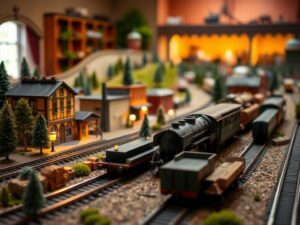How to Upgrade Your HO Scale Layout for Better Performance
How to Upgrade Your HO Scale Layout for Better Performance
Level Up Your Rails! A Comprehensive Guide to Upgrading HO Scale Layout Performance
Welcome back, rail enthusiasts! Today we’re diving into the exciting world of upgrading your HO scale layout performance. Whether you’re just starting out or you’ve been building railroads for years, there’s always room to improve the flow, realism, and overall enjoyment of your model railway.
We all love that feeling: watching those meticulously crafted engines pull gleaming passenger cars or powerful freight trains around our carefully detailed layouts. But sometimes, something feels off â perhaps slow speeds, inconsistent stopping power, derailments, or simply a lack of smooth operation. Fear not, fellow train fanatics! With a few strategic upgrades and adjustments, we can transform your HO scale layout from good to truly outstanding.
The Foundation: A Strong Track System is Key
Your track system is the lifeline of your entire model railway. It carries the power to your trains and guides them safely around the layout. That means its quality directly impacts how well your locomotives perform and how realistic the overall experience feels. So, let’s start with the essentials:
-
Track Choice Matters: There’s a reason why Atlas® Code 80, Kadee®, Bachmann®, and Lionel® are favorites among hobbyists â their sturdy construction and precise rail gaps translate into better electrical contact and smoother rolling stock. Consider these factors when choosing track:
- Gauge (Code): HO Scale generally uses Code 83 or Code 100 rails. Code 83 is common for realistic appearances while Code 100 offers a larger profile, often preferred for heavy freight applications.
-
Clean Track, Happy Trains: Dust and grime are the enemies of good electrical conductivity. Regularly clean your track with a dedicated track cleaner tool or a solution of mild soap and water followed by dry cotton swabs.
- Secure the Rail Connections: Loose rail joiners (the tiny connectors) can create resistance, slowing down your trains and even causing shorts. Ensure all joiners are firmly seated using specialized tools like the GaugeMaster Track Joint Sealer or Bachmann® Pin Vice for perfect contact.
- Tip for Enthusiasts: Consider solderable joiners to eliminate any gap between rails, further reducing resistance and improving conductivity.
The Electrical Backbone: Power Your Railway Efficiently
A consistent power supply is essential for reliable operation. We need a solid base that can handle your entire layout’s demands.
- Choose the Right Power Pack: Select a power pack with sufficient output voltage and amperage to accommodate all the locomotives and accessories you plan to run simultaneously.
- Beginner Tip: Start with a 50-120 Watt power supply, and upgrade as your layout expands.
-
Derailing Protection (Surge Suppressors): Protect your valuable locomotives from sudden power surges by installing a dedicated surge protector. This can prevent costly damage caused by lightning strikes or electrical fluctuations.
-
DCC for Ultimate Control: Consider investing in a DCC (Digital Command Control) system if you want ultimate control over speed, direction, and individual locomotive operations. DCC allows for advanced programming, lighting effects, sound capabilities, and more. Itâs like having your own railroad symphony at home!
Rolling Stock: Keep Those Wheels Turning Smoothly
Your choice of locomotives and rolling stock also plays a crucial role in smooth operation.
- High-Quality Gears: Choose models with high-quality, precision-machined gears to minimize wear and tear, ensure consistent rotation speeds, and prevent gear meshing noise.
-
Wheels Matters!: Look for wheels that are the correct size for your chosen track gauge (Code) and offer a smooth rolling surface. Consider aftermarket wheel sets for improved performance and smoother running characteristics.
-
Trucks That Track: Carefully inspect truck construction (the metal underframes that support the car bodies) for secure bearings and good wheel contact with the rails. Properly aligned trucks ensure that cars stay on track even at higher speeds.
- Enthusiast Tip: Lubricate wheels, axles, and moving parts periodically to minimize friction and enhance overall performance.
Layout Design: The Foundation for Success
- Grade Your Way!: Gradual slopes help create realism and guide rolling stock movement smoothly. Avoid steep inclines that can strain motors or cause derailments, especially on tight curves.
- Curvature Consideration: Trains handle tighter curves better at slower speeds. Make sure your radius (curve diameter) allows for comfortable operation based on the size of your locomotives and cars.
-
Space Matters!: Provide adequate space for locomotives to switch directions and navigate turnouts efficiently. Crowded layouts can lead to bottlenecks and derailments.
Tools of the Trade: Elevate Your Workmanship
- Essential Track Tools:
- GaugeMaster Pin Vice – Used to adjust rail joiners and improve conductivity.
- Flexible Wire Strippers & Crimpers: Ideal for wire management, connecting LEDs, and ensuring a secure electrical connection for accessories.
Troubleshooting Like a Pro
If your layout seems sluggish or prone to derailments: - Essential Track Tools:
- Visual Inspection: Carefully examine the track for loose connections, bent rails, or debris obstructing the path.
- Voltage Check: Use a voltmeter to measure voltage at various points on your track and compare it to the output of your power pack. If there’s significant drop in voltage, it indicates a power issue.
- Cleaning is Key: Regular cleaning of wheels and rails eliminates grime that can disrupt conductivity.
- Test Individual Equipment: Try operating locomotives and rolling stock individually on different sections of the layout to pinpoint the problem area.
Final Thoughts: Itâs All About Personalization!
Remember, your HO scale layout is a unique expression of your creativity and passion for railroading. As you upgrade, prioritize features that enhance your enjoyment and realism. Whether it’s detailed scenery, intricate wiring techniques, or cutting-edge DCC systems, make it yours!
By investing time in understanding these principles and implementing the upgrades we’ve discussed, you can significantly improve the performance, smoothness, and overall visual appeal of your HO scale layout. Soon, youâll be enjoying an authentic model railway experience that rivals the real thing â all from the comfort of your own home. Happy railroading!




